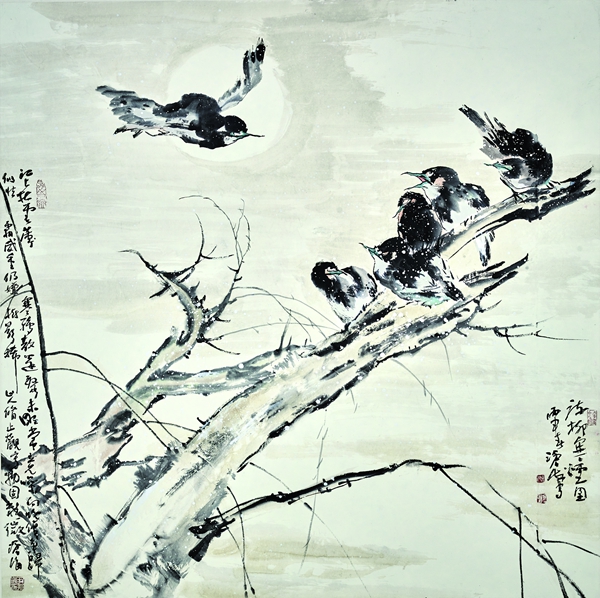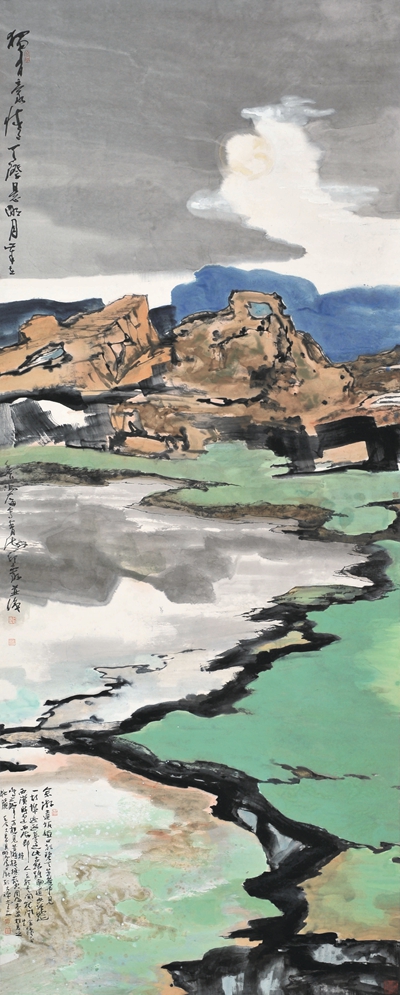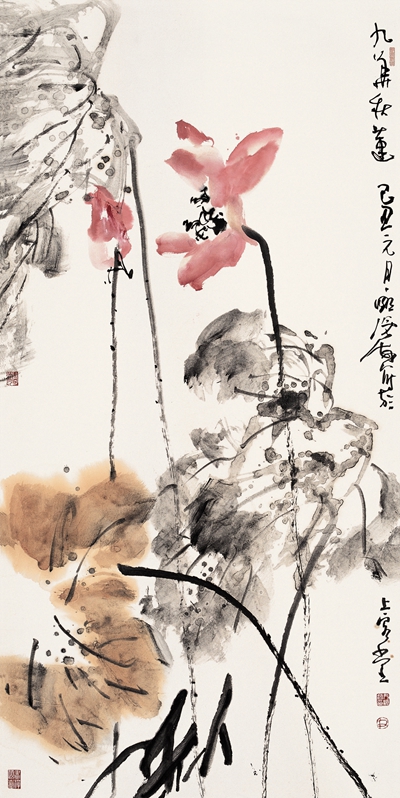Views Influence Mindset, Techniques & Practice Advance Together
Impression of YIN Canghai

Scattered willows in cold smoke YIN Canghai

Unique Confidence YIN Canghai

Autumn lotus in Jiuhua Mountain YIN Canghai
When the artist of the Tang dynasty ZHANG Zao talked about artistic creation, he once said: "Stemming from natural environment, arts are created by artists’ inner minds". The Northern Song dynasty painter FAN Kuan also said: "The method for painting landscape of predecessors is by observing environment. Rather than learning from them, I should observe the landscape carefully. Rather than observation, I had better choose the technique and genre I prefer. " The two artists have stated the artistic rules of China’s traditional creation of painting through different means: the artist infiltrates and transforms objects with his own emotions and thoughts, creating artistic works with unique aesthetic styles through selecting, processing and sublimating. YIN Canghai, professor of Nankai University and vice-chairman of the Tianjin Artists Association, is an artist who emphasizes nature with traditional cultivation, artistic thinking and independent aesthetic pursuit. His Chinese paintings cover a wide range of subjects, including characters, landscapes, flowers and birds, involving people, Buddhist and pommel horses, deities, famous mountains and rivers, holy mountains and pavilions, exotic scenery, flowers, birds and fish, fruit and vegetable, the benevolent and many other topics out of the real life. His large landscape style paintings were magnificent while featuring genuine temperament in paintings about characters, flowers and birds. The works are exquisite in writing and focusing on paintings and calligraphy especially in the form of "compact body", "dispelling body" and "work brush". The style of YIN is pure, innocent and natural, while embodying the aesthetic interest of poetry and Zen-style in the painting, presenting sound and safe mood out of the reality.
Poetic Dwelling
For the blending of poetry and painting, YIN Canghai believes: "The so-called 'seeing nature’ of Zen Buddhism and the Taoist ideas represented by Zhuang Zi’s pursuit of the aesthetic attitude to the harmony between man and nature complement the Confucianism, which is the philosophical foundation for the blending of poetry and painting. The Chinese people's unique aesthetic concepts and tastes, after thousands of years of literary artist's creative practice, showcase strong empathy in term of the literati paintings, with the calligraphy as the bone and the poems as the soul, pointing straight to people’s heart." Viewing the paintings of YIN Canghai, Smoke in Winter, Admiring Crescent in Distance, Fish and Moon and other works are deep but not obscure with simple and natural brushwork, full of vitality. His paintings often illustrate the bleak atmosphere of TAO Yuanming, splendid ambition of LI Bai and SU Shi, and sometimes the sketches reveal the strong character of DU Fu's "sudden frustration". The rhyme of the poets is often shown by his brushes: "Inexplicable east wind disturbs my heart" "Free fish under calm water in autumn" and "The moonlight brightens at midnight."…revealing thick painting and poetic feelings.
"Natural" is the core aesthetic pursuit of Chinese painting. "Natural", on one hand, has the meaning of "by the light of nature", requiring paintings to be as free as possible of artificial traces. On the other hand, there is the intention of "learning from the nature", emphasizing that the painters must get close to the nature and observe its genuineness. The aesthetic pursuit of "natural" has a direct connection with the concept of "nature" of Lao Zi and Zhuang Zi’s philosophy and that of metaphysics of Wei and Jin dynasties. In a word, it expresses the true nature of the natural world with the brushwork of "light", "clumsy" and "honest".
The closeness to "nature" is also an important feature of Yin Canghai's Chinese painting creation. He said: "The artist must not only observe the abundance of the objects to be depicted before he enters the creative state in a rational and physical manner, but at the same time he should be moved by the harmonious order of the ‘natural beauty’." His observation of nature is "a poet's perspective of the object", which means "Emotion is embedded in nature", and the splashing brushwork entrusts his enthusiasm for the pastoral nature as the painter uses the brush of innocence and nature to find himself a poetic dwelling.
Taoist Nature
The creation of Chinese painting art pays special attention to the true feelings of ordinary life. YIN Canghai believes: "Sensations of life include 'feelings-preservation-consciousness', which cannot occur without unhesitating thinking of materials of life or understanding by heart. Otherwise, even if 'looking for it forever’, it’s hard to find. It includes 'visiting' and experience, containing memories and reflections, but also long-term accumulation of ideas, life and knowledge." It is in this reflection and precipitation of a sense of real life that the artist condenses and regularizes the individual emotions that were originally trivial, complicated and unordered, and constitutes an artistic personality sufficient to cradle the creative practice.
The free expression of self-life experience is the purpose of "freehand" of the Chinese painting, but this free expression is not a mess of ink and brush, and the overflow of the painter’s subject status still requires relying on rules and orders. According to YIN Canghai, understanding and dealing with the relationship between natural and artistic order is an extremely important aspect in the dialectical manner. He said: "Grasping the theory and knowledge of nature is necessary for the painting process. However, with this rational knowledge in hand, it does not indicate that we can draw a good picture. What is important is that, during painting process, the non-decomposing and conceptual and pure consciousness of activities as 'sit still', 'deformation' and 'de-intelligence' resolve and integrate nature's principles. The artistic spirit conveyed in this state of creation, although a manifestation of one's own personality, is able to directly reach the nature of the object, hence, it also reflects the order of nature and expresses the artistic order. "
Upon talking about the relationship between freehand brushwork of flower and bird and Zen freehand paintings, YIN Canghai stated that Zen's "Without reminding words, he uses wisdom to observe himself to reach the realm", and Lao Zi and Zhuang Zi’s "Taoist Nature" and "Return to Baby Status" are all intended to tell about the ways for human being to return to natural status. And the natural characteristic of freehand flower and bird painting, first of all, requires artists of freehand painting to return to their own hearts and the originality of all issues. YIN Canghai's paintings and calligraphy all showcase the Zen style of freehand brushwork. His Bodhidharma Facing The Wall, Lotus and Birds, Empty Landscape with Flowing Water and Flowers, All About Ways, All About Time,God with Free Heart and other works, characterized by the spirit, form and language of Zenstyle paintings, feature flying strokes while grasping the charm of ink, depict a silent and elegant art-world of ink based upon freedom.














